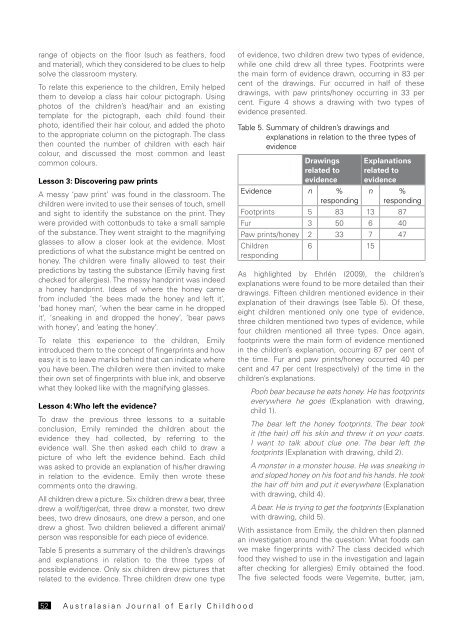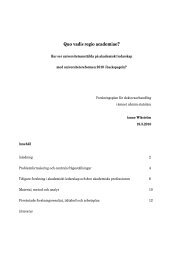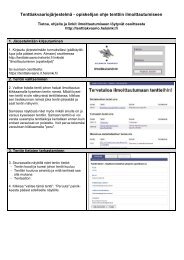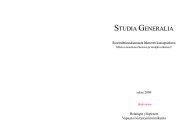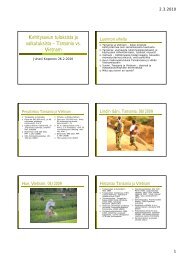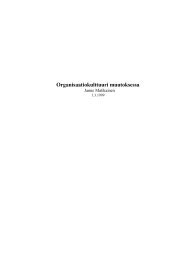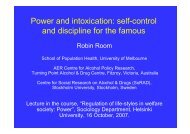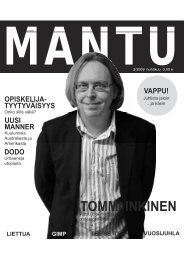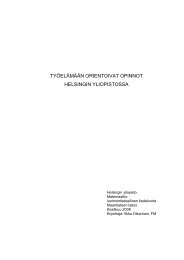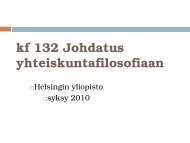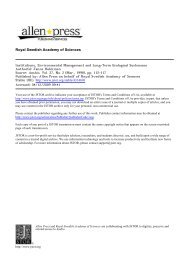ange <strong>of</strong> objects on the floor (such as feathers, foodand material), which they considered to be clues to helpsolve the classroom mystery.To relate this experience to the children, Emily helpedthem to develop a class hair colour pictograph. Usingphotos <strong>of</strong> the children’s head/hair and an existingtemplate for the pictograph, each child found theirphoto, identified their hair colour, and added the phototo the appropriate column on the pictograph. The classthen counted the number <strong>of</strong> children with each haircolour, and discussed the most common and leastcommon colours.Lesson 3: Discovering paw printsA messy ‘paw print’ was found in the classroom. Thechildren were invited to use their senses <strong>of</strong> touch, smelland sight to identify the substance on the print. Theywere provided with cottonbuds to take a small sample<strong>of</strong> the substance. They went straight to the magnifyingglasses to allow a closer look at the evidence. Mostpredictions <strong>of</strong> what the substance might be centred onhoney. The children were finally allowed to test theirpredictions by tasting the substance (Emily having firstchecked for allergies). The messy handprint was indeeda honey handprint. Ideas <strong>of</strong> where the honey camefrom included ‘the bees made the honey and left it’,‘bad honey man’, ‘when the bear came in he droppedit’, ‘sneaking in and dropped the honey’, ‘bear pawswith honey’, and ‘eating the honey’.To relate this experience to the children, Emilyintroduced them to the concept <strong>of</strong> fingerprints and howeasy it is to leave marks behind that can indicate whereyou have been. The children were then invited to maketheir own set <strong>of</strong> fingerprints with blue ink, and observewhat they looked like with the magnifying glasses.Lesson 4: Who left the evidence?To draw the previous three lessons to a suitableconclusion, Emily reminded the children about theevidence they had collected, by referring to theevidence wall. She then asked each child to draw apicture <strong>of</strong> who left the evidence behind. Each childwas asked to provide an explanation <strong>of</strong> his/her drawingin relation to the evidence. Emily then wrote thesecomments onto the drawing.All children drew a picture. Six children drew a bear, threedrew a wolf/tiger/cat, three drew a monster, two drewbees, two drew dinosaurs, one drew a person, and onedrew a ghost. Two children believed a different animal/person was responsible for each piece <strong>of</strong> evidence.Table 5 presents a summary <strong>of</strong> the children’s drawingsand explanations in relation to the three types <strong>of</strong>possible evidence. Only six children drew pictures thatrelated to the evidence. Three children drew one type<strong>of</strong> evidence, two children drew two types <strong>of</strong> evidence,while one child drew all three types. Footprints werethe main form <strong>of</strong> evidence drawn, occurring in 83 percent <strong>of</strong> the drawings. Fur occurred in half <strong>of</strong> thesedrawings, with paw prints/honey occurring in 33 percent. Figure 4 shows a drawing with two types <strong>of</strong>evidence presented.Table 5. Summary <strong>of</strong> children’s drawings andexplanations in relation to the three types <strong>of</strong>evidenceDrawingsrelated toevidenceEvidence n %respondingExplanationsrelated toevidencen %respondingFootprints 5 83 13 87Fur 3 50 6 40Paw prints/honey 2 33 7 47Childrenresponding6 15As highlighted by Ehrlén (2009), the children’sexplanations were found to be more detailed than theirdrawings. Fifteen children mentioned evidence in theirexplanation <strong>of</strong> their drawings (see Table 5). Of these,eight children mentioned only one type <strong>of</strong> evidence,three children mentioned two types <strong>of</strong> evidence, whilefour children mentioned all three types. Once again,footprints were the main form <strong>of</strong> evidence mentionedin the children’s explanation, occurring 87 per cent <strong>of</strong>the time. Fur and paw prints/honey occurred 40 percent and 47 per cent (respectively) <strong>of</strong> the time in thechildren’s explanations.Pooh bear because he eats honey. He has footprintseverywhere he goes (Explanation with drawing,child 1).The bear left the honey footprints. The bear tookit (the hair) <strong>of</strong>f his skin and threw it on your coats.I want to talk about clue one. The bear left thefootprints (Explanation with drawing, child 2).A monster in a monster house. He was sneaking inand sloped honey on his foot and his hands. He tookthe hair <strong>of</strong>f him and put it everywhere (Explanationwith drawing, child 4).A bear. He is trying to get the footprints (Explanationwith drawing, child 5).With assistance from Emily, the children then plannedan investigation around the question: What foods canwe make fingerprints with? The class decided whichfood they wished to use in the investigation and (againafter checking for allergies) Emily obtained the food.The five selected foods were Vegemite, butter, jam,52A u s t r a l a s i a n J o u r n a l o f E a r l y C h i l d h o o d
honey and flour. Food was chosen for this fingerprintinvestigation as it allowed the children an opportunityto connect with their everyday experiences <strong>of</strong> eatingat home, how dirty fingers can leave marks, and theimportance <strong>of</strong> cleaning hands after eating. Food alsoallowed the children to consider a wide range <strong>of</strong>options, and decide as a class which to select.Figure 4. Two examples <strong>of</strong> children’s drawingsshowing different evidence.Lesson 5: Conduct the investigationTo conduct the investigation in an orderly manner, Emilyspread a different food onto the bottom half <strong>of</strong> five plasticsheets. In groups <strong>of</strong> four, the children were encouragedto place their finger into the food and then press theirdirty finger into the top half <strong>of</strong> the plastic sheet to leavea fingerprint. Magnifying glasses were provided to allowthe children to observe their fingerprints in detail. Thechildren were also encouraged to use a different fingerfor each food to assist in developing their fine motorskills. After the children made their fingerprints, many<strong>of</strong> them licked their fingers. Once finished, each childwashed their hands and completed a worksheet thatEmily had developed, which asked them to circle thosefoods that made prints, and then pick which food theythought made the ‘best’ fingerprint. Of the 17 childrenpresent during the lesson, the children’s response tothis last question was: Vegemite (9), jam (3), honey (2),flour (2) and butter (1).The children then went on a bear hunt in the playground.As they made their way around the play equipment,along the bike path, and across the sandpit, theydiscovered more evidence ‘planted’ by Emily, includingfur, honey handprints and footprints. They finally arrivedat a makeshift bear cave where they found a notefrom a friendly bear explaining that he had been in theclassroom to admire the children’s work; that he hadleft the footprints, fur and honey; and that he couldn’tbe there now as he was out collecting honey.DiscussionThe discussion relates to the opportunities providedto develop the children’s inquiry skills and knowledgethrough the forensic science program. It concludes witha discussion <strong>of</strong> the sociocultural aspects <strong>of</strong> the program.This series <strong>of</strong> lessons readily embraced the scientificinquiry skills. Exploration, questioning and predictionwere a continual part <strong>of</strong> the lessons, as each piece<strong>of</strong> evidence was inspected in detail. While nearly allchildren predicted that a print had been left behindin Lesson 1, their responses on what had left thefootprint ranged from reasonable (bear, cat, dog, tigeror humans), incorporating the children’s own personalinterests (dinosaurs), to highly imaginative (monstersor giants). The children found it harder to justify whatthis unknown thing was doing in the classroom. Onceagain, responses ranged from logical (stealing thecomputer, trying to break the table, or sneaking in),attempting to understand how the prints were made,through to a realisation that this was a mystery to besolved (‘it’s a mystery!’). This last comment reflectsthe understanding <strong>of</strong> one child as to the purpose <strong>of</strong> theforensic science lessons.Vo l u m e 3 6 N u m b e r 3 S e p t e m b e r 2 011 53
- Page 3 and 4:
1.5 Display, download or print the
- Page 5 and 6: Volume 36 Number 3 September 2011Jo
- Page 7 and 8: Curriculum guidelines for early lit
- Page 9 and 10: ■■Know that print carries meani
- Page 14 and 15: Korean children’s cultural adjust
- Page 16 and 17: The Early Years Learning Framework
- Page 18: Kyung Min said listening in class w
- Page 21 and 22: immediately impact on children’s
- Page 23 and 24: Child participation in the early ye
- Page 25 and 26: their kindergarten day. A study by
- Page 27 and 28: the overall organisation, routines,
- Page 29 and 30: Council of Australian Governments (
- Page 31: Learning to measure length in the f
- Page 34 and 35: ■■a 40-minute, one-on-one inter
- Page 36 and 37: ■■72 per cent of the project sc
- Page 38 and 39: In other words, the difficulties th
- Page 40 and 41: An analysis of New Zealand’s chan
- Page 42 and 43: Before five also gave equivalent st
- Page 44 and 45: some evidence that curriculum effec
- Page 46 and 47: achievement; aiding transition to s
- Page 49 and 50: ‘It’s a mystery!’A case study
- Page 51: analysis of discourse the children
- Page 58 and 59: Observation and recording informati
- Page 60 and 61: ‘I’m making it different to the
- Page 62 and 63: Purpose and theoretical frameworkIn
- Page 64 and 65: The fingers were reaching out acros
- Page 66 and 67: Figure 7. ‘I take this lovely lad
- Page 68 and 69: Here, Rachel used substitution to r
- Page 70: Evaluating the feasibility, effecti
- Page 73 and 74: Table 2. Descriptive characteristic
- Page 75 and 76: The children in this study were fro
- Page 77 and 78: Vol. 36 No. 3 September 2011Austral
- Page 79 and 80: implement the curriculum effectivel
- Page 81 and 82: Table 2. Mean differences between H
- Page 83 and 84: can be regarded as one of the infor
- Page 85 and 86: Ganser, T. (2000). An ambitious vis
- Page 87 and 88: (Buckhalt et al., 2009). Reduced qu
- Page 89 and 90: invited families having difficulty
- Page 91 and 92: Table 3. Mean hours of mother and f
- Page 93 and 94: A reduction in night wakings might
- Page 95 and 96: A preliminary exploration of childr
- Page 97 and 98: adult support necessary for its eff
- Page 99 and 100: Children’s cortisol and alpha-amy
- Page 102 and 103: Connor, C., Son, S.-H., Hindman, A.
- Page 104 and 105: Equity of access:Requirements of In
- Page 106 and 107:
excursions, which have been reporte
- Page 108 and 109:
We need a bus but we also need a st
- Page 110 and 111:
Appropriate child careIndigenous fa
- Page 112 and 113:
Australian Institute of Health and
- Page 114 and 115:
The Mosaic Approach relies on child
- Page 116 and 117:
participants (Altrichter, Posch, &
- Page 118 and 119:
distance. This involved trying to b
- Page 120 and 121:
Dockett, S., & Perry, B. (2003). Ch
- Page 122 and 123:
experiences (Bandura, 1997). Belief
- Page 124 and 125:
the curriculum while on their profe
- Page 126 and 127:
Exploring and evaluating levels of
- Page 128 and 129:
Level 2: Attending to feelingsThis
- Page 130 and 131:
This process to ensure coder stabil
- Page 132 and 133:
DiscussionStructured reflective pro
- Page 134 and 135:
Rock, T. C., & Levin, B. B. (2002).
- Page 136 and 137:
issues encountered in their caring
- Page 138 and 139:
pertaining to the impact and suppor
- Page 140 and 141:
Parents felt the policies involving
- Page 142 and 143:
and access suitable carers because
- Page 144 and 145:
Ievers, C. E., & Drotar, D. (1996).
- Page 146:
www.earlychildhoodaustralia.org.auE


